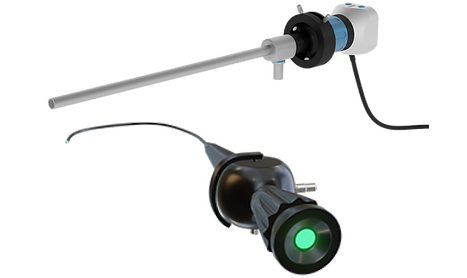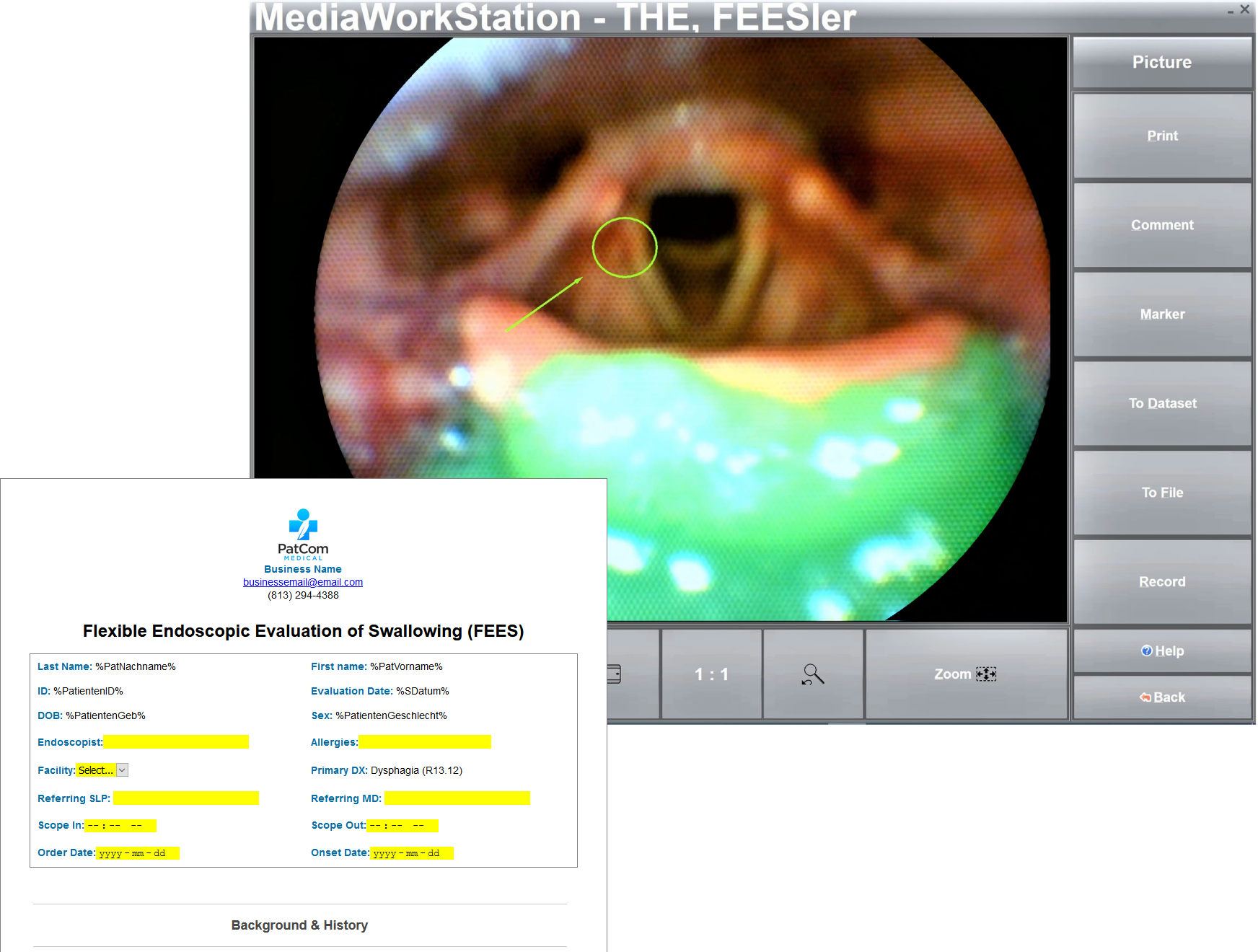PatCom Videostroboscopy With Global Shutter Technology
Videostroboscopy with rigid and flexible endoscope
Rigid endoscope set up for high definition image quality and ultra high brightness.
Camera technology with global shutter for image quality without compromise.
Strobe light with 3 speed slow motion capability, body sound microphone and foot pedal.
Flexible endoscope set up for patient comfort and clinical efficiency.
One simple USB connection for ultimate portability and technical simplicity.
Portable set up for videostroboscopy covering inpatient and outpatient.
The PatCom Strobe system for Videostroboscopy can be used with a rigid endoscope (also known as Hopkins rod-lens) as well as a flexible fiberoptic endoscope.
The benefit of using PatCom Medical rigid endoscopes is image quality. Even the most sophisticated flexible endoscopes available today fall short of the image quality that can be produced with rigid endoscopes and an external camera during videostroboscopy. The reason behind it is the large diameter of the rigid endoscope as well as its design of glass lenses. It allows more light to travel through and to be projected onto the large camera sensor of the external camera.
The benefit of using PatCom Medical flexible fiber optic endoscopes is flexibility. A 3.4mm diameter nasal flexible endoscope is sometimes better tolerated by patients than a 10mm diameter rigid endoscope that is placed trans-orally. Furthermore, the flexible endoscope set up allows the clinician to perform not only stroboscopy but other assessments such as FEES or laryngoscopies.
There are pros and cons to both set ups and the best set up might be the combination of both rigid endoscope and flexible endoscope videostroboscopy.
The M-Cam HD camera that PatCom Medical uses for its videostroboscopy application is a global shutter camera. This shutter technology is beneficial when there is no continuous light source. It will avoid horizontal lines and artifacts. In addition to this, the camera is equipped with a button to regulate exposure time during videostroboscopy. This allows the camera to accept more light in to produce a brighter image. The camera does not require a control unit and instead connects to either Windows or Mac computers with one USB cable.
The Software
For a successful Videostroboscopy exam the recording of both video and audio is important. The evaluation of the vocal folds with Stroboscopy is very much an assessment of the visual aspect (video) as well as the sound (audio) As far as the video recording is concerned there should be several basic features that your software should include:
- Take snapshot of video frame. This is to add a still image of the vocal folds to your report.
- Play/Pause to stop your video for examination and to take a high quality snap shot.
- Fast Forward to navigate through your recording quicker.
- Slow Motion to evaluate anatomical movement in great detail.
- Frame by Frame movement through the video recording to utilize highest quality frames.
- Advanced: Split screen functionality to compare video sequences and follow patient progress.
The PatCom software suite includes multiple software options that are tailored to your specific needs. A basic software design including all features mentioned above is available. For hospitals requiring a patient database, Dicom capabilities and higher compliance levels a separate software solution is offered. Your PatCom representative can discuss the different software solutions in detail.
The Service
- Pledge to raise industry standard of customer service to new levels
- 7 day technical support by phone, email and text
- Remote access software service included
-
Free loaner during repair
One of the the main reasons PatCom Medical Inc. was established is the desire to commit to a level of customer service that goes above and beyond what others do. The PatCom service concept includes a variety of more and less common elements that ensure our customers are able to perform their own work without interruption. However, it this the underlying understanding of everyone at PatCom to make our customer’s problems ours to solve that sets us apart.
As responsiveness is a key element of good service we offer support 7 days a week by phone, email and text. We offer remote access service free of charge where we have the ability to take control of your Stroboscopy system’s computer to solve any software related issues within minutes.
If your equipment ever needs to be serviced at our service center we offer free loaners during the repair process. To keep the turn around time itself as short as possible a US based service center is available.
There is a chance that you have existing stroboscopy equipment from a third party manufacturer. PatCom Medical is able to provide service for a number of systems and is able to integrate new equipment with what you already own.
What are Voice Disorders?
A voice disorder is when the voice has a problem with pitch, volume, tone, and other aspects. These problems occur when the vocal folds (vocal cords) don’t vibrate normally.
Voice is the sound that is created when air is pushed out of the lungs and passes through the vocal folds. Vocal folds are the two folds of tissue inside the larynx (voice box). The vibration of those cords is what produces speech.
In order to create normal speech, the vocal folds need to touch together gently inside the larynx. Anything that interferes with vocal fold movement or their contact can cause a voice disorder. Many voice disorders can be cured with treatment when diagnosed early.
PatCom Medical aims to be a loyal partner to Speech Language Pathologists and Ear Nose and Throat Doctors performing Videostroboscopy. Having the right equipment, training and support allows the clinician to focus on what is most important: the patient.
What is Videostroboscopy?
Voice disorders are often caused by problems in the larynx (voice box) and/or throat, a thorough examination of the voice box and throat is key to the identification of the etiology of voice disorders. Laryngeal Videostroboscopy enables the view of the vocal folds (vocal cords) to see how they move. The vibration of the vocal folds is too fast for the human eye to see the actual movement. During regular speech, the vocal folds of a male vibrate an average of 100-130 times a second, and for a female, the vocal folds vibrate an average of 190-220 times a second. Laryngeal Videostrobscopy uses a strobe light (flashing light) to create a series of images that appear to be slow motion of the vocal folds movement. Slowing down the vibration of the vocal folds allows the clinical assessment of such movement.
The combination of excellent medical equipment for the procedure of flexible or rigid scope videostroboscopy and one of a kind customer service is how Patcom Medical would like to win and keep their customers. The team at PatCom has many years of experience in the field and is committed to doing its part in improving patient care on an ongoing basis.
Contact Us
US Office
Buffalo, NY 14203
Canadian Office
Etobicoke, ON, M9B 6H7



